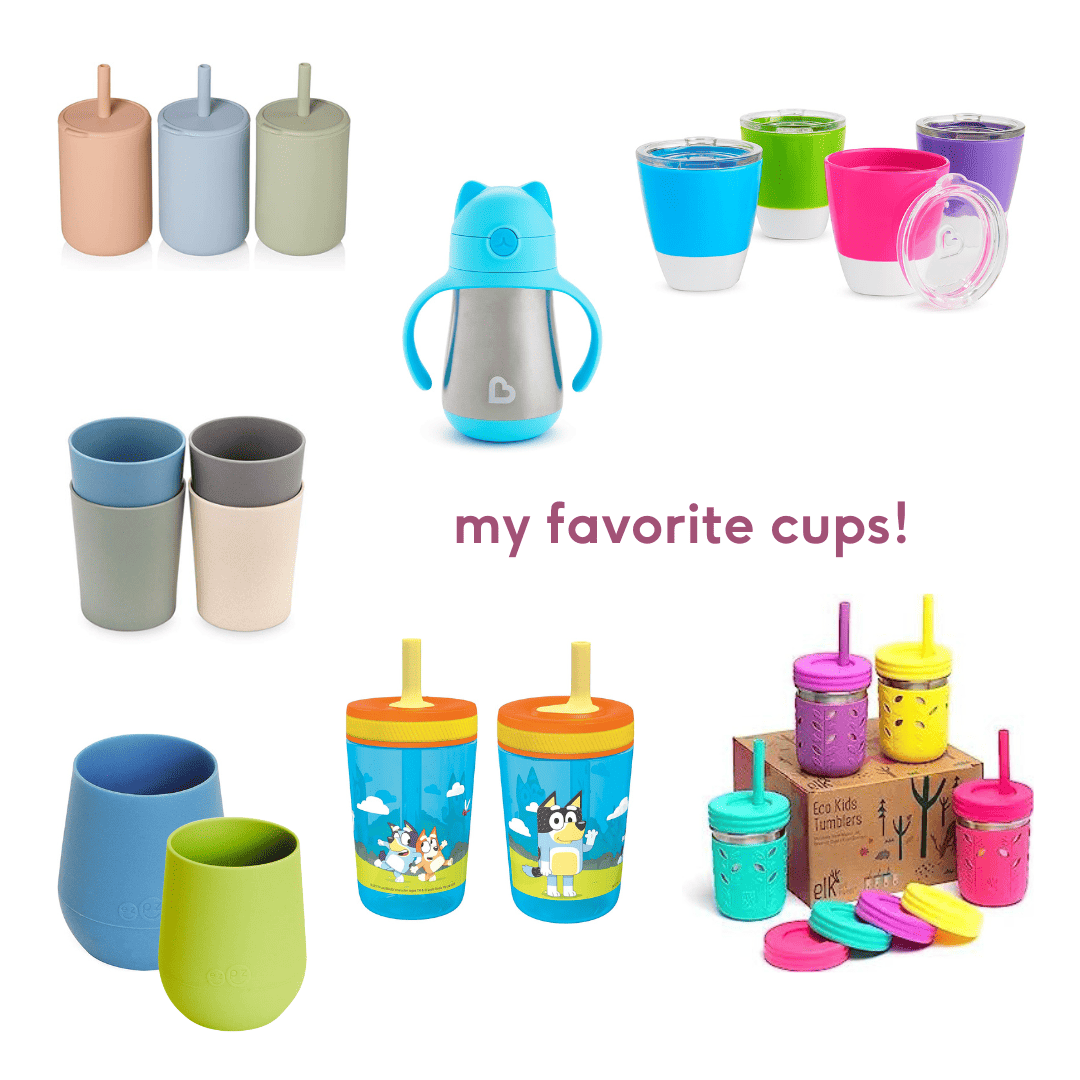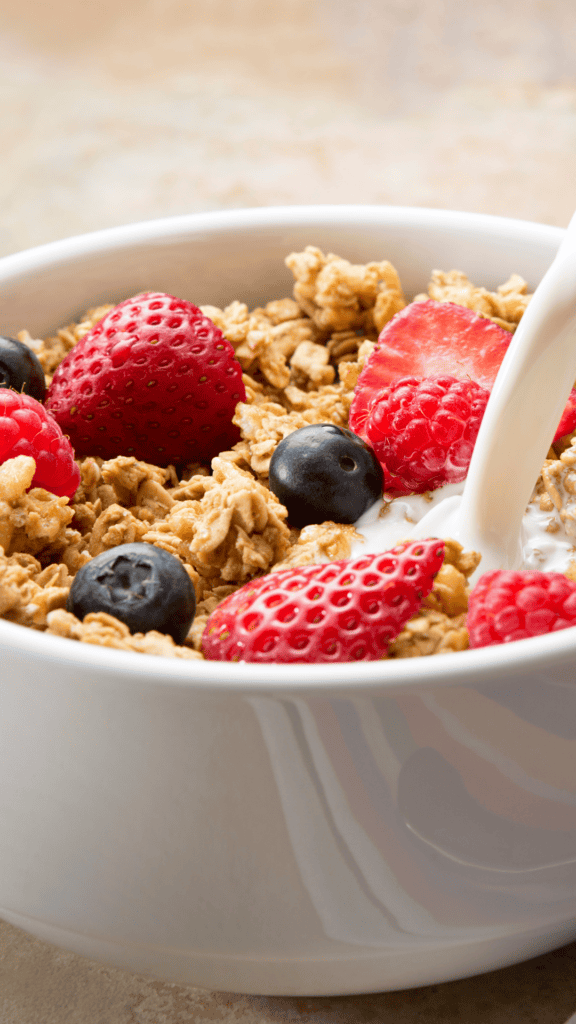Milk for Toddlers: Answering All Your Questions on Cow’s Milk, Non-Dairy Alternatives & Hormones
Nov 06, 2019, Updated May 23, 2025
This post contains affiliate links. Please see our disclosure policy.
Table of Contents
- Milk for Toddlers
- More Posts on Milk Topics
- 1. Do toddlers need milk?
- 2. How much milk should toddlers drink?
- 3. Non-Dairy Milk and Plant Based Milk for Toddlers: Yes or No?
- 4. What’s the best kind of milk for toddlers?
- 5. When should toddlers & kids drink milk?
- 6. What’s the deal with hormones in milk?
- 7. Conventional vs. Organic vs. Grass-fed, etc.
- A Note for Concerned Parents:
- What goes better with milk than cereal?
Table of Contents
- Do toddlers need milk?
- How much milk should toddlers drink?
- Non-Dairy Milk for Toddlers: Yes or No?
- What’s the best kind of milk for toddlers?
- When should toddlers & kids drink milk?
- What’s the deal with hormones in milk?
- Conventional vs. Organic
Milk for Toddlers
I get questions about milk for toddlers all. the. time! (Btw – this post was reviewed and updated October 2023.)
With dairy alternatives becoming more and more popular (and many parents navigating a milk allergy), parents are starting to wonder about the best options for their kids. And since I know a lot of you guys are wondering, I was super happy to write up a post all about milk for toddlers.
Before we get started, I want you to know that your child can be completely healthy both with or without cow’s milk. It’s more of a personal preference for what’s best for them and for your family, and whatever choice you make is totally okay.
With that in mind, I made sure to include key information about both milk and milk alternatives, so that you can feel good about whatever option is right for your littles when you introduce milk.
Note: this post contains affiliate links. As an Amazon Associate, I earn from qualifying purchases at no extra cost to you.
More Posts on Milk Topics
What to Do if Your Toddler isn’t Drinking Cow’s Milk (Nutrition & Drinking Tips)
Soy Milk for Toddlers: Is it Bad?
Almond Milk: Should my toddler drink it?
1. Do toddlers need milk?
In short? No.
Milk is an awesome source of protein, fat, vitamin D, and calcium, but it’s not the only way toddlers can get those nutrients. Breast milk or formula is sufficient for children under 1. If you try milk with your child over 12 months, great- it can help support healthy growth and development! But you don’t have to.
If your little one doesn’t drink cow’s milk, you’ll just want to find other sources of those same nutrients that they like to eat (or drink). Milk is something that I think many kids enjoy AND many parents like to use as a way to cover some nutritional bases. But it is by no means the only way to make sure your child gets what they need.
Vitamin D
Many young children do not get the recommended amount of vitamin D and calcium daily. You can use a vitamin D supplement like D Drops, which are fine to use past baby age.
Calcium
You’ll want to look to other calcium rich solid food to replace that found in cow’s milk. Some ideas:
Dairy:
Yogurt
Cheese
Non-Dairy:
Tofu
Sesame seeds
Broccoli
Ground flax
Almond butter
Dried figs
Fortified orange juice
Non-dairy cheese and yogurt also often contain calcium, but check labels to be sure!
2. How much milk should toddlers drink?
I recommend 16-20 oz (around 2 to 2.5 cups per day) of milk for toddlers, and no more than 3-4 servings a day. For kids that do like milk/dairy, we don’t want to overdo it because too much dairy can crowd out other important things in the diet. It can also contribute to some tummy troubles in excess.
By 18 months, you should move from a bottle to a straw cup or open cup for milk. My favorites are here.

One serving of dairy for a toddler is:
- ½ cup milk
- ⅓ cup yogurt
- ½ oz cheese (a cheese stick is 1 oz)
If your toddler is drinking 2-2.5 cups of milk a day, they won’t need any additional dairy on top of that. For some children, too much dairy leads to constipation.
If your toddler is only drinking 1 cup (or less) of milk a day, they’re probably not getting the recommended amount of calcium. You’ll want to include other calcium-rich foods from the list above in their diet.
If your toddler is drinking more than 2.5 cups of milk a day, you’ll want to cut back. Like I mentioned above, too much milk can crowd out other important nutrients from their diet. It can also contribute to iron deficiency, both because milk actually decreases iron absorption and because it can crowd out iron-rich foods.
3. Non-Dairy Milk and Plant Based Milk for Toddlers: Yes or No?
It’s totally okay if your child doesn’t drink cow’s milk! you’ll just want to make sure they get the nutrients found in cow’s milk in other ways.
According to the American Academy of Pediatrics, the best non-dairy milk alternative for toddlers is fortified soy milk. Although the American Academy of Pediatrics (AAP) only recommends fortified soy milk as a nutritional equivalent to cow’s milk, I personally see unsweetened pea milk (like Ripple) as a close second.
There are always new products coming out on the market- especially in the alternative milk world. I recommend always glancing at the nutrition label of any ‘milk’ you’re curious about. Compare the fat and protein content to cow’s milk. And, reviewthe important micronutrients we’ve mentioned as well- like vitamin D and calcium.
TIP: Look for non-dairy milk that has calcium carbonate instead of calcium triphosphate.
Calcium carbonate is better absorbed by the body. And another reason to check: some non-dairy milks are actually not fortified with calcium at all!
Wondering about almond milk in particular? I wrote a whole post about it, which you can read here!
4. What’s the best kind of milk for toddlers?
Whole fat milk, 2%, 1%, or skim? I get asked all the time!
For children aged 12 months to 2 years old, I recommend whole milk exclusively. That’s because the fat content is great for your young toddler’s brain and central nervous system growth and development.
Once they turn two, it’s really up to you. Personally, I still serve whole milk, because the fat content keeps my kids fuller longer.
The AAP also recommends avoiding flavored milks to minimize added sugar in your toddler’s diet, and to avoid having them develop preferences for extra sweet tastes.
And if you’re worried about it, it’s good to know that the link between saturated fat (the type of fat found in dairy) and heart disease is not as strong as people once thought it to be. I’m totally comfortable serving whole milk products to my kids!
What about DHA milk?
DHA-fortified milk has the polyunsaturated Omega-3 fatty acid called docosahexaenoic acid added to it. DHA is an important, brain-boosting fatty acid that we need to consume in the diet. When it’s added to milk, that can be an easy way to weave it into our kids’ diets! Other dietary sources of DHA include fish, flaxseed, and eggs.
What is ultra filtered milk?
Ultra-filtered milk is milk that has been filtered through multiple membranes during its processing to create a more concentrated milk product. Because of the ultra-filtration, it contains almost twice the amount of protein, less lactose, and less water. In fact, its actually lactose-free (after they add back in lactase to neutralize the small amount of lactose left after processing).
It’s a great option for kids who maybe only drink a few ounces of milk, but you’d like for them to get more protein per ounce!
It’s also great to cook with (think: oatmeal or baking mixes) to up the protein content.
My kid only likes chocolate milk…which one is best?
Like I mentioned above, the AAP does recommend avoiding flavored milk in the name of limiting added sugar in the diet. However, I totally get that for some kids, that’s the only way they’ll drink milk!
My tip here would be to mix a few ounces of chocolate milk with whole or 2% milk so that you’re getting the flavor, but minimizing the sugar.
You could also try making your own by squeezing just a smidge of chocolate syrup into plain milk- enough so that your child will drink it, but not too much so that we can still manage the added sugar intake.
If you are looking for a decent store bought chocolate milk option, I do think the Fairlife brand one is pretty good. It’s lower in added sugar than almost all the other brands you’ll see on the shelves!
What about raw milk?
I’ve noticed raw milk is gaining popularity these days. I wrote a whole post about it here where I break down all the information about raw milk (and goat’s milk!) as well as highlight some of the risks of consuming raw milk. (Spoiler alert: it’s not pasteurized- that’s why its considered “raw”, and therefore it may still have potentially harmful bacteria that is usually killed by the pasteurization process.)
5. When should toddlers & kids drink milk?
It’s always best to consume milk with meals, for a few reasons:
Nutrient Absorption
Your toddler’s body does a better job of absorbing the nutrients in milk with food than it does when drinking milk without eating. It also can be a great complement to a meal that is otherwise lacking a protein source. Sometimes I find that protein can be a little harder to get in at breakfast. I love serving a glass of milk as an option (or milk in the cereal) to complement a carbohydrate-forward meal.
Good Habits
From a habits perspective, I prefer to see milk served with meals vs. as a comfort item that they carry around with them.- This is especially important when you’re trying to break the habit of bottles and transition to open cups. Milk is and can be a really great comfort item. But we also want to help them view it as part of meals and snacks,not just an all-the-time bottle/sippy cup item
Healthy Teeth
It’s better for teeth to keep milk with meals as opposed to having your toddler drinking it all day long. While milk doesn’t have any added sugar, it does contain naturally-occurring lactose- which is milk sugar. Having this in contact with teeth all day every day can lead to dental problems like cavities.
6. What’s the deal with hormones in milk?
Most dairy cows (both organic and conventional) are no longer injected with hormones. You may see your milk carton says “rBST-free,” or “rBGH-free,” which means the cows never received any type of growth hormone. There are very few farmers who still use these hormones, and the hormones are being completely phased out of use.
Hormones have kind of a bad rap, but it’s because they get lumped in with something called Insulin-Like Growth Factor, or IGF, which is found in milk. Cows that get hormone treatments do have more IGF, but because IGF is found in both animal and soy protein sources, we know that milk is not the problem.
It’s also worth noting that consuming dairy itself is not shown to be a cancer risk, but some epidemiological studies have shown that excess protein MIGHT be (the research is still inconclusive). So, if your child loves cow’s milk, or you want them to have it, go ahead and serve it! This research tells us it’s more about making sure we have a balanced diet than anything else.
7. Conventional vs. Organic vs. Grass-fed, etc.
There are a few buzzwords around milk that get a lot of attention. Wonder what they REALLY mean? Conventional vs. organic vs. grass-fed milk. What’s the real difference?
I want to start off by saying that while there ARE some differences (and valid reasons you might opt for one type over another for your family), they are nearly nutritionally identical. So you don’t necessarily need to feel like you have to buy one brand or purchase at a particular price point in order to reap the benefits of milk for your kids.
Organic vs. conventional
The FDA guidelines for organic milk state that the cows have not been treated with antibiotics and must never be given hormones. They cannot be given hormones for either reproduction or growth. And, they must be fed at least 30 percent of their diet on pasture.
Non-organic, or conventional cows, are typically not given hormones either, but they are technically allowed to. You can always tell if you’re buying milk from cows that have not been given hormones. The carton will state that it is rBGH-free or rBST-free milk.
Organic also means that cows are only given feed that was grown without the use of certain commercial fertilizers or pesticides.
Grass-fed vs. organic
‘Grass-fed’ and ‘organic’ sometimes get lumped together as synonymous terms, but they don’t actually mean the same thing. Grass-fed refers only to the diet eaten by the cows, while organic also includes the stipulations listed above. Grass-fed essentially means what it sounds like! The cows eat grass (as opposed to grain/feed).
Here is a helpful article from The Dairy Alliance that lays out all the differences between the types of milk and what each label does and doesn’t mean.
Like I said, all of these milks are nearly identical from a nutritional angle, so I want you to feel the freedom to buy whatever suits your family best. If you feel passionate about organic farming/animal practices, buy organic! If you’re looking to get the most bang for your buck to feed a milk-loving slew of kids, don’t feel any guilt from me grabbing the conventional! You’re still providing your family with all of the amazing benefits of milk no matter what you choose.
A note on antibiotics
As far as antibiotics go, cows on conventional farms must have any antibiotics out of their system before their milk is usable again.
How to learn about conventional dairy farms near you
If you’re curious about where your milk comes from, do a quick search for local dairy farms in your area. Most of the milk you see lining the shelves at your grocery store comes from relatively local dairy farms- likely within about 100 miles.
A Note for Concerned Parents:
A healthy diet can be one that does or does not contain cow’s milk. As always, you have to do what is best for your family and your child’s individual needs and preferences.
Kids do not need to drink cow’s milk in order to be healthy, and drinking it doesn’t mean that they’re NOT healthy!
On the flip side, it’s also okay if your kid LOVES milk. It can be a great part of a healthy diet. I just want you to be equipped with all the information so that you can help set the appropriate limits to ensure they’re getting the variety they need in their diets!
What goes better with milk than cereal?
Okay, maybe cookies. Maybe.
But seriously! If you’re thinking about the best milks to serve your child, I think you’d also love this FREE Low Sugar Cereal List.















I grew up on cow’s milk, now as I grow up I prefer the alternatives for many reasons, even if I am not lactose intolerant, however, no matter how much I try to inform myself, I still haven’t made up my mind on what is best for a child.
My 13 month old drinks about 15oz of whole milk per day (usually three 5oz bottles). He does also consume 1 or 2 servings of additional dairy (cheese in the form of a cheese stick, Mac and cheese, or grilled cheese etc) or yogurt per day although we have cut back. Some days a few of his bowel movements have become small pellets and he seems to be straining. I believe it’s from too much dairy? If I give him 15 oz of whole milk – should I not be offering any other dairy? If I offer Mac and cheese or grilled cheese should I cut one bottle? Having trouble navigating when to offer whole milk and how much – and if this may be causing constipation in my son
Hey April! I am so sorry you’re struggling with that! You can definitely try to cut back on dairy to see if it makes a difference, but also check out this post on constipation to see what else to avoid or limit and what foods to increase to help! https://mamaknowsnutrition.com/foods-to-help-with-constipation-in-toddlers/
What about hormones in soy milk? Estrogen issues?
My son has a dairy protein allergy which is why we choose Ripple (pea protein) he’s been drinking it since he was a year old. He recently turned 4 and has started throwing his milk back up. He only throws up the milk. Any ideas what this could be from? We’ve just stopped giving it to him.
First of all this is amazing!!! Thank you for writing this up for all of us! Can goat milk apply to what you’ve written?
Hello hello I have a few questions
-I’m a SAH mom and I pump only at night (mostly fore milk). When my LO is a year can’t I add a liquid Calcium and Vitamin D&K supplement to the breast milk instead of giving her cow’s milk?
-what’s you professional opinion on goat’s milk?
Thank you
Hey Anna! Yep you could do that, continuing the breastmilk in place of cows milk. Goat’s milk can be easier to digest and has a similar nutrient profile to cows milk, so I would recommend it if you’d like to try it!
Is estrogen looped into the hormone analysis? Because it’s a “natural” hormone it may not Have been checked as much, so can a cow get pumped with 3x, 4x, 5x the natural amount and then it’s ok for children?
In terms of farms, I wish there were more Farms like the one You mentioned- that’s not the norm.
Animal cruelty not mentioned at all – toddlers should maybe watch the process and then be asked if they want the milk. Thoughts there?
What about all the concern regarding soy and hormone disruption? Is this actually studied?
Hey Sarah! This piece from Harvard does a great job summarizing the info around soy! https://www.hsph.harvard.edu/nutritionsource/soy/
Hi! This is SO helpful thank you! A few questions regarding my 13.5 month old 🙂
-if he doesn’t finish his cup of milk at his meal, do I offer it again with his next snack or stick with water for snacks and just incorporate more dairy foods into his next meal time to make up for lost ounces?
-should all snacks take place in his highchair if possible instead of on the living room floor?
-my son likes almost every food but will only feed himself the first few bites and then gets distracted? I then have to continue to put food in his mouth to make sure he eats, or give him something like a lid to play with to distract him, or both :O I hope I’m not messing him up too bad 🤣 any tips?
THANK YOU SO MUCH, I feel so lost.
Hey Tara, if he doesn’t finish his milk you can re-offer at snack time, that’s fine! I do prefer snacks to be in the highchair vs. the floor (mostly to prevent choking hazard- if he’s on the floor he’s more likely to be moving around). As for getting distracted, I would sit with him and give him a break for a minute or two, maybe talk to him or sing a song or something, and then re-direct him to his food. But when he’s no longer interested in feeding himself, it could be a sign that he’s not very hungry anymore, so I would just pay attention to that. He may be done after a few bites, and that would be okay. Hard for me to know without being there myself though, of course! And you’re not messing him up, you’re doing great! It’s hard and none of us are perfect in this feeding journey 🙂
Would you recommend 16-20oz of a non-dairy milk (pea protein) a day as well? Thanks!
Hi yep the same amount 🙂
Thanks for this!!
How do you feel about Oat Milk? Also, how does breastmilk beyond 1 year compare to cows milk or non dairy milk? Would they still get enough calcium/vitamin D depending on how many ounces they drink?
Oat milk is okay to use like for baking or on occasion but it’s not a good replacement for cows milk or breast milk, it doesn’t have the same nutrition. As for breastmilk beyond 1 year, it’s amazing, but they would need a vitamin D supplement (regardless of how much they drink) because breastmilk is not a good source of vitamin d. Hope that helps!